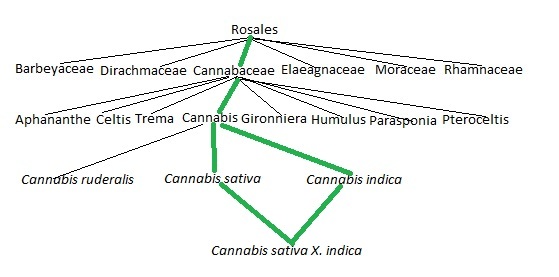•Domain: Eukarya
•Kingdom: Plantae
•Phylum: Magnoliophyta (Angiosperm Magnoloid)
•Class: Magnoliopsida
•Order: Rosales
•Family: Cannabaceae
•Genus: Cannabis
•Species: Cannabis sativa X indica (modern) species used for medicine are hybrids between the two closely related species of Cannabis.

Domain: Eukaryote
Marijuana belongs in the Eukaryotic kingdom because, it has a true nucleus and membrane bound organelles.
Kingdom: Plantae
It is part of the Plantae domain, because it is multicellular, contains chloroplasts for photosynthesis, and has cell walls for structural support.
Phylum: Magnoliophyta
Cannabis sativa X indica is part of the Magnoliophyta (Angiosperm) phylum, because it produces seeds, has flowers, and fruiting bodies contain the seeds. Members of the Magnoliophyta start their development as seeds.
Class: Magnoliopsida
Because of the branching veins in its leaves, marijuana is placed in the Magnoliopsida class. Marijuana has two embryonic leaves with net-like veins. In addition, marijuana has one major root called a tap root and many smaller peripheral roots growing out from the main tap root.
Order: Rosales
The order Rosales that marijuana belongs to has few unifying morphological features (things we can see), but are linked together by genetic similarities. One morphological feature shared by members of Rosales is along the stems leaves alternate with stipules. In addition, flowers usually have five sepals and petals.
Family: Cannabacea
Marijuana fits into the family Cannabaceae for several reasons: Cannabaceaes are pollinated by the wind, have separate male and female plants, and often have radial symmetry in clusters of leaves.
Genus: Cannabis
The genus Cannabis is fitting for marijuana, plants because marijuana has lobed and serrated leaflets along with flowering naturally each year it is alive.
Return to Homepage
To learn about marijuana living outside view the Natural Habitat page.